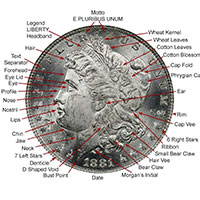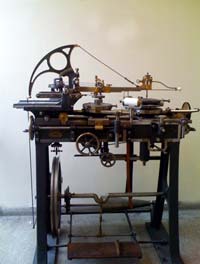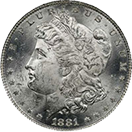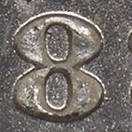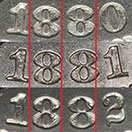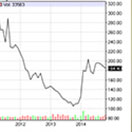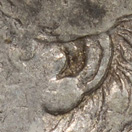
April 2016 - Welcome
Sources
Search
Contact
Home
Welcome
Click on year to expand
2022
2021
2020
2019
2018
2017
2016
2015
Welcome
![]() There is always something going on in our world of the 1881-O and this month will be no exception. Our on-line inventory is at 440 coins, and in April we hope to increase that by another 20+ when our latest images arrive from VSS.
There is always something going on in our world of the 1881-O and this month will be no exception. Our on-line inventory is at 440 coins, and in April we hope to increase that by another 20+ when our latest images arrive from VSS.
![]()
![]() We have another 20 raw coins at PCGS for grading and expect those back in the third week of April. All of these should be graded AU or higher except for one coin that hopefully hit a lower grade gap for the grading side of the web site.
We have another 20 raw coins at PCGS for grading and expect those back in the third week of April. All of these should be graded AU or higher except for one coin that hopefully hit a lower grade gap for the grading side of the web site.
![]()
![]() We also have a few coins scheduled to be analyzed by LVA and we will probably combine them with any coins needing analysis from VSS this month.
We also have a few coins scheduled to be analyzed by LVA and we will probably combine them with any coins needing analysis from VSS this month.
![]()
![]() When the PCGS coins come back we have a group of 20 coins to go in as a crossover submission. There are some lower grade coins in that group and it should be interesting to see how many cross.
When the PCGS coins come back we have a group of 20 coins to go in as a crossover submission. There are some lower grade coins in that group and it should be interesting to see how many cross.
The 1881-O Market
We have seen very little change in the market over the past month, and doubt we will see much, even in the highest grades. The stabilization of the price of silver has frozen the lowest grades, and the higher grades do not respond to the bullion markets.
The auction sites we follow have not changed much on price other than the one MS66 we noted last month. We did make an inquiry on that coin, but without success.
Mentoring and Young VAMers
This month we have added a small section on encouraging the hobby of VAMing with young collectors. We tend to think of the complexities of VAMing and less of how you can get youngsters involved.
Our belief is that younger collectors can get involved with VAMing with a little help and our hobby can take on a longer term view with a constant stream of new people to the hobby.
This will not be a view shared by all, but getting your children and grandchildren away from their smart phones for a while and teaching them the critical thinking that comes with this hobby will pay dividends for us all.
Overpolished Wings
We recently started a conversation on polishing variations in the wings on different dies. We finally had a chance to take a look at this issue and have posted the results in the Similitudes link in the a4bove menu.
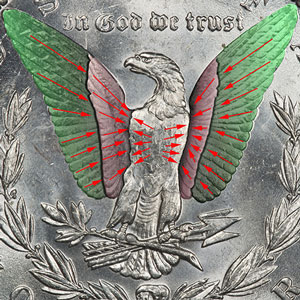
This is one of those issues that we almost wish had never been raised, because with the exception of the true overpolished wings there is a lot of subjective opinion in the results.
When does a wing have just enough polishing to have the detail "softened"? When does the softening become true overpolishing? Does strike hurt the analysis?
At the end of the day we were able to at least take a stab at the issue. Short of the true overpolished varieties the rest is subject to some conjecture and should be dealt not with skepticism but with the knowledge that this is a highly subjective analysis.
New Coins
We also acquired a number of coins this month that we believe to all be VAM 5, and they will need to go in a lot of directions before winding up at VSS. Some are raw coins for the PCGS grading route, some are crossovers for PCGS, and a few are ready to go to VSS.
We are looking for raw, clashed examples right now to close our gap on missing VAMs from the collection. For some strange reason clashed coins seem to run in waves where there are none, and then there are a lot. Right now there are many of them out there and we are grabbing them while we can.
A Really Messed Up Coin
Somehow we opened a can of worms on VAMworld in discussing this coin that we found on eBay.
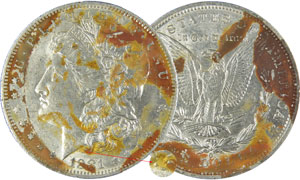
The coin had something on it that looks like caramel candy, but could have be anything from glue, to grease, to who knows what. We were only interested because the coin has the look of a VAM 5, but we needed to get it in hand to be sure.
When the coin arrived it appeared to be a VAM 37A and not a VAM 5. The goop was obscuring a portion of the curls we look to for the identification of the VAM 5. But we only have one VAM 37A and this will be a welcomed addition if it can be restored.
Then there will be the fun of trying to get all the goop off of the coin. Our first attempt was to give it a bath in distilled water just too see if the substance was adhering to the surface lightly. That produced nothing, so we then tried a quick bath in acetone, but this also produced nothing. So then it was on to a little secret sauce which started to produce the results we were seeking.
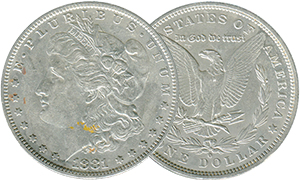
This image was flattened by our scanner, so it does not show the reflectivity. But the yellow substance is almost gone, whatever it is. This is a dramatic shift from the original state of the coin with the goop only adhering to a few of the deepest recesses. We have been surprised to learn that the goop actually protected the surface of the coin and where it was is actually in better shape than the other areas.
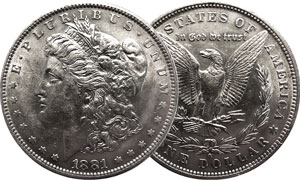
The above image shows try three and all the goop is gone except for some very small amounts in the denticles which we will need to analyze. These images came from our cell phone and the flash makes them a little flat, which is not accurate. They retain a lot of reflectivity for an AU coin.
We continue to work on it and since this is a low value coin there is little risk. We may eventually send it in for a "restoration" by one of the grading services if we cannot restore it on our own.
Getting Started
Collecting The 1881-O
The 1881-O VAMs
